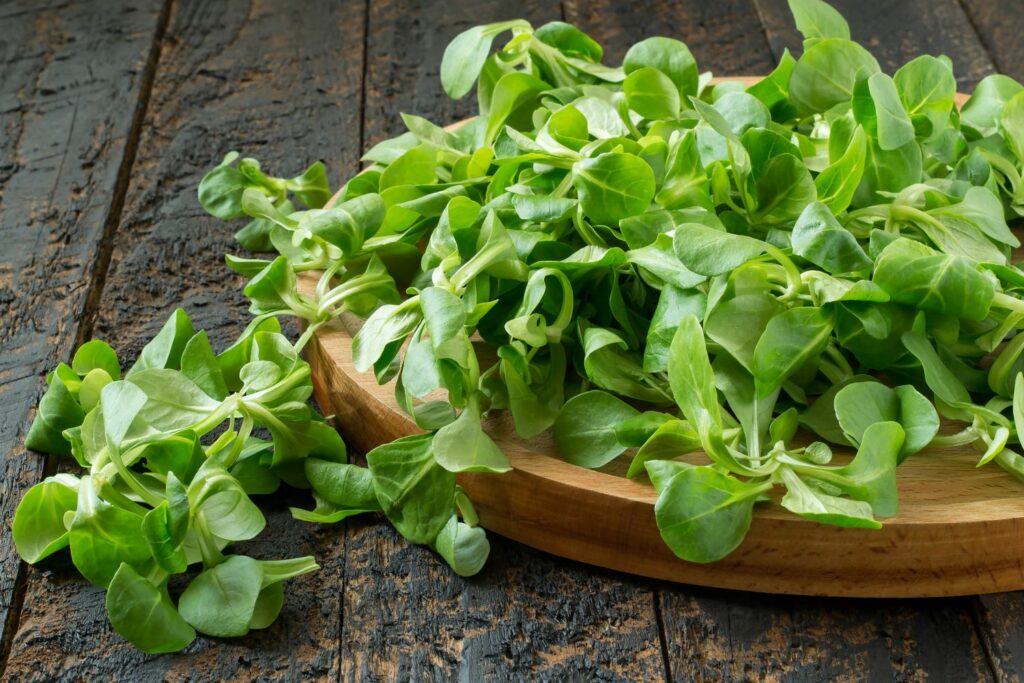Growing lamb’s lettuce: sowing, location & care
Lamb’s lettuce is a fantastic crop that can be used in salads all winter long. Discover this leafy green, including how easy it is to grow lamb’s lettuce at home so you too can enjoy this delicate yet flavourful crop.

Lamb’s lettuce (Valerianella locusta) is a popular autumn and winter crop that has a mild flavour and a nutty aroma. It is a key ingredient in winter salads, but new bolt-resistant lamb’s lettuce varieties have made it possible to grow it year round. Read on to learn more about this easy-to-grow and surprising leafy crop.
Contents
Growing lamb’s lettuce: when is the best time?
Lamb’s lettuce, also known as cornsalad, is native to southern Europe. However, nowadays, it is a common sight in both Europe and North America. The plant is a low-growing hardy annual with a high tolerance to cold conditions. It has small spoon-shaped leaves that taste slightly tangy. The plant gets its name from the leaf’s resemblance to a lamb’s tongue.
Lamb’s lettuce seeds can be sown at various times throughout the year, both outdoors and under cover. For crops in late spring or early summer, sow undercover in late winter or early spring. For summer harvests, sow outdoors in early to mid-spring. Or, for a harvest in winter or spring, sow lamb’s lettuce seeds outdoors in summer from July to September.
It is a fast-growing crop and mature plants are ready to harvest after only 12 weeks, even sooner if you wish to harvest smaller leaves. The crop can take several cuttings and will resprout after being harvested if the plant’s growth centre remains intact. When harvesting lamb’s lettuce, either pick single leaves as required or cut off the whole head of the plant, leaving behind the base to resprout.

The right location
Lamb’s lettuce is a fairly simple and undemanding plant that will grow in almost any soil. It is adaptable and can thrive in a wide range of soils and conditions. Ideally, choose a site with fertile and well-cultivated soil as it may struggle in poor and moist soil. If your chosen location has heavy soil, improve the soil before planting, so that your lamb’s lettuce’s growth is not impacted. When it comes to light levels, lamb’s lettuce is perfectly happy in both full sun and light shade in the summer.
Lamb’s lettuce happily grows in a raised bed or pot. Fill the bed or container with a high-quality compost that is full of nutrients to help feed the plants throughout the season. We recommend using our Plantura Organic All Purpose Compost as it is peat-free, made from 100% natural ingredients and contains added fertiliser to help plants grow big and strong.
Planting lamb’s lettuce
Lamb’s lettuce plants are small, about 10 cm tall and wide and are generally sown directly outdoors in the garden bed. However, lamb’s lettuce will grow well indoors too. Lamb’s lettuce can be grown in a greenhouse, cold frame or even on a windowsill.

Sowing lamb’s lettuce seeds
To sow lamb’s lettuce seeds directly in the garden, first prepare the area. Weed, rake and remove any large stones from the plot, and mix in some well-rotted manure or compost. Sow the lamb’s lettuce seeds thinly in narrow drills around 0.5 – 1 cm deep and 3 cm apart. Leave 10 – 20 cm between rows. Cover the seeds with soil and water well. Germination should take two to three weeks, after which thin out the seedlings to 10 cm spacings.
The process for sowing lamb’s lettuce seeds indoors to give the plants a head-start on weeds when planting them out is straightforward. Fill pots or trays with a good quality potting compost. Sow the seeds about 0.5-1 cm deep and keep them somewhere bright with a temperature between 16 and 20 °C. Once the seedlings emerge, cultivate them at a somewhat cooler temperature of 5 – 12 °C.
Planting out lamb’s lettuce
Once the lamb’s lettuce seedlings reach 4 – 5 cm and have their first cotyledons, plant them out in their final location. Lamb’s lettuce grows well in many types of gardens, so plant them out in your location of choice in either raised beds, containers, window-boxes, or in garden beds. When planting lamb’s lettuce out, space the plants about 10 cm apart and water them in well.

Caring for lamb’s lettuce
Keep lamb’s lettuce seedlings constantly moist after planting out, especially for the first three weeks. Regularly check the plants and water as required, this may be more often if you are growing lamb’s lettuce indoors.
When growing lamb’s lettuce, it is key to reduce competition from weeds. Regularly remove weeds, either by hand or by using a hoe between the rows of plants. By removing the weeds, the lamb’s lettuce will not have to compete for nutrients in the ground and also will not get swamped by taller-growing weeds.
Fertilising is not a necessity when growing lamb’s lettuce. Provided the soil is fertile, it should be happy throughout the season. If you want to overwinter lamb’s lettuce, consider adding some fertiliser to give the plant a boost.
Lamb’s lettuce is a great winter salad alternative. Another similar but lesser-known winter leaf is winter purslane (Claytonia perfoliata). Find out more about this under-utilised winter crop in our article on growing winter purslane.



















